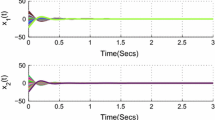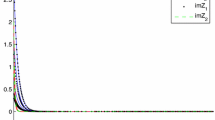Abstract
In this paper, a class of complex-valued neural networks including two additive time-varying delay components has been discussed. By making use of the combinational Lyapunov-Krasovskii functional and free weighting matrix method, as well as matrix inequality technique, a delay-dependent criterion of stability is derived.
Access provided by CONRICYT-eBooks. Download conference paper PDF
Similar content being viewed by others
Keywords
- Complex-valued neural networks
- Additive delay components
- Stability
- Lyapunov-Krasovskii functional
- Time-varying delays
1 Introduction
With the application of artificial intelligence technology, the research of artificial neural networks (NNs) is becoming more and more important. Especially, in the past twenty years, neural networks have been applied in many fields, such as optimization problem, associative memory, model identification, pattern recognition, signal processing, and other engineering and scientific areas, so the neural network is attracting more and more attention [1]. As we all know, in the process of the realization of neural networks, time delays often occur, which may lead to the performance of neural networks to reduce, or even induce instability [2]. Therefore, the research of delayed NNs have attracted great interest, also many stability criterion have been obtained [1,2,3,4,5].
Meanwhile, in the literature [6], the authors introduced a new type of time-varying delay with two additive components in the state of neural networks. In many practical applications, such as remote control, network control system, etc., we may encounter such a system. For example, in networked controlled systems, the signal transmitted from one location to another location may experience some segments of networks, which can possibly cause a series of delays. Due to the uncertain network transmission conditions, the delay of the sensor to the controller has different characteristics with the controller to actuator delay. This means that the study of the system having time-vary delays will become more complicated and more meaningful. Therefore, the stability of the NNs having additive time-varying delays have been widely investigated [6,7,8,9].
Complex-valued NNs is an extension of real-valued NNs, due to its practical applications of complex-valued neural networks in physical systems for processing quantum waves, electromagnetic, ultrasonic and light, complex-valued NNs consisting of complex-valued states, outputs, connection weights, and activation functions has also become a research hot spot [10]. In addition, some problems can be only solved by complex-valued NNs, but cannot be solved by real-valued NNs [11]. At present, some achievements have been obtained in the study of stability of various complex-valued neural networks, relevant results are available in [12,13,14,15,16,17,18,19,20]. In [12,13,14,15,16], the methods used to examine the stability of complex-valued NNs were still using the method of analyzing the stability of real-valued NNs. It is a method of dividing complex-valued NNs into two parts, real parts and imaginary parts. However, this method will bring two questions. One problem is that the dimension of the real-valued NNs is twice as much as the complex-valued neural network. This will result in the difficulty of analysis. The other is that the real and imaginary parts of the activation function need to be distinct, but there is lack of a analytical form to express such difference. In [17,18,19,20], under the condition that both the real and imaginary portions of the complex-valued neural network were not split, the stability of the system was explored. Several criteria for the stability of the system were obtained.
In the above complex-valued NNs, the time delay in a state was only a singular form. However, as far as we know, few scholars have studied the stability of the complex-valued NNs having additive time-varying delays so far. Based on the above analysis, we study the problem. In the second section of this article, we described the problem and made some preparatory work. In the third section, we did the analysis of delay dependent stability of complex-valued NNs having additive time-varying delay. Then by making hybrid use of the Lyapunov-Krasovskii functional and the free weighting matrix approach, innovative delay dependent stability criteria are derived.
2 Problem Description and Preliminaries
The stability analysis of complex-valued NNs having two additive time-varying delays components is examined.
\(s\ge 0\), \(z(s)=(z_{1}(s),z_{2}(s),\cdots ,z_{n}(s))^{T}\in {\mathbb C}^{n}\), where \(z_{i}(s)\) is the state of the ith neuron at time t, \(i=1,2,\cdots , n\); \(f(z(s))=(f_1(z_1(s)),f_2(z_2(s)),\cdots ,f_n(z_n(s)))^T\in {\mathbb C}^{n}\) is the vector-valued activation function; \(A=(\mathbf {a}_{ij})_{n\times n}\in {\mathbb C}^{n\times n}\) and \(B=(\mathbf {b}_{ij})_{n\times n}\in {\mathbb C}^{n\times n}\) are the connection weight matrices; \(C=\mathrm{diag}\{c_{1},c_{2},\cdots ,c_{n}\}\in {\mathbb R}^{n\times n}\) is the self-feedback connection weight matrix, where \(c_{i}>0\); the input vector is \(J=(J_{1}, J_{2},\cdots , J_{n})^{T}\in {\mathbb C}^{n}\); \(\tau _{1}(s)\) and \(\tau _{2}(s)\) are two time-varying delays.
The following assumptions are made:
(H1). Two time-varying delays should meet the following conditions
where \(\tau _{1}, \tau _{2},\mu _{1},\mu _{2}\) are constants, and we denote
(H2). There exists a diagonal matrix \(L=\mathrm{diag} \{l_1,l_2,\cdots ,l_n\}\) such that
for all \(\gamma _{1},\gamma _{2}\in \mathbb {C}\), where \(l_{i}>0\).
The initial conditions of model (1) are \(z_{i}(u)=\phi _{i}(u)\), \(u\in [-\tau ,0]\), where \(\phi _{i}\) is continuous and bounded on \([-\tau ,0]\), \(i=1, 2, \cdots , n\).
To simplify the model, suppose that \(\tilde{z}\) is an equilibrium point of system (1), using the transform \(y(s)=z(s)-\tilde{z}\), (1) is converted to the following system
where \(g(y(s))=f(y(s)+\tilde{z})-f(\tilde{z})\).
3 Main Result
Theorem 1
Under the assumptions of (H1) and (H2), system (2) is globally asymptotically stable given the seven positive-definite Hermite matrices \(P_{i}\) (\(i=1,2,\cdots ,7\)), two real-valued positive diagonal matrices R and S, four complex-valued matrices \(Q_{i}\)(\(i=1,2,3,4\)) such that the following complex-valued LMI holds:
where \(\varPi _{11}=-P_1C-CP_1+P_{2}+P_{3}+P_{4}+P_{5}+C(\tau _1P_{6}+\tau _2P_{7})C+Q_2+Q_2^{*}+KRK\), \(\varPi _{12}=-Q_2\), \(\varPi _{16}= P_1A-C(\tau _1P_{6}+\tau _2P_{7})A\), \(\varPi _{17}= P_1B-C(\tau _1P_{6}+\tau _2P_{7})B\), \(\varPi _{18}= Q_2\), \(\varPi _{22}=-(1-\mu _1)P_{2}+Q_1+Q_1^{*}\), \(\varPi _{23}=-Q_1\), \(\varPi _{29}=Q_1\), \(\varPi _{33}=-P_{3}+Q_4+Q_4^{*}\), \(\varPi _{34}=-Q_4\), \(\varPi _{3,10}=Q_4\), \(\varPi _{44}=-(1-\mu )P_{4}+Q_3+Q_3^{*}+KSK\), \(\varPi _{45}=-Q_3\), \(\varPi _{4,11}=Q_3\), \(\varPi _{55}=-P_5\), \(\varPi _{66}=A^*(\tau _1P_{6}+\tau _2P_{7})A-R\), \(\varPi _{67}=A^*(\tau _1P_{6}+\tau _2P_{7})B\), \(\varPi _{77}=B^*(\tau _1P_{6}+\tau _2P_{7})B-S\). \(\varPi _{88}=-\frac{1}{\tau _1}P_6\), \(\varPi _{99}=-\frac{1}{\tau _1}P_6\), \(\varPi _{10,10}=-\frac{1}{\tau _2}P_7\), \(\varPi _{11,11}=-\frac{1}{\tau }P_7\), others are zero.
Proof
The Lyapunov-Krasovskii functional candidate for model (2) is constructed as follows
where
From assumption (H1), calculating the time derivative of \(V_1(s)\), \(V_2(s)\), \(V_3(s)\) and \(V_4(s)\), we get that
From assumption (H2), we can get
By Newton-Leibniz formula, we have
By Eqs. (12), (15), (16), (17), (18) and inequality (13), (14), we can get
where
\(\tilde{\varPi }=(\varPi _{ij})_{7\times 7}\), \(\varPi _{ji}=\varPi ^*_{ij}\), \(\varOmega =(\varOmega _{ij})_{7\times 7}\), \(\varOmega _{ji}=\varOmega ^*_{ij}\), \(\varPi _{11}=-P_1C-CP_1+P_{2}+P_{3}+P_{4}+P_{5}+C(\tau _1P_{6}+\tau _2P_{7})C+Q_2+Q_2^{*}+LRL\), \(\varPi _{12}=-Q_2\), \(\varPi _{16}= P_1A-C(\tau _1P_{6}+\tau _2P_{7})A\), \(\varPi _{17}= P_1B-C(\tau _1P_{6}+\tau _2P_{7})B\), \(\varPi _{22}=-(1-\mu _1)P_{2}+Q_1+Q_1^{*}\), \(\varPi _{23}=-Q_1\), \(\varPi _{33}=-P_{3}+Q_4+Q_4^{*}\), \(\varPi _{34}=-Q_4\), \(\varPi _{44}=-(1-\mu )P_{4}+Q_3+Q_3^{*}+LSL\), \(\varPi _{45}=-Q_3\), \(\varPi _{55}=-P_5\), \(\varPi _{66}=A^*(\tau _1P_{6}+\tau _2P_{7})A-R\), \(\varPi _{67}=A^*(\tau _1P_{6}+\tau _2P_{7})B\), \(\varPi _{77}=B^*(\tau _1P_{6}+\tau _2P_{7})B-S\). \(\varOmega _{11}=\varPi _{11}+\tau _1Q_2P_6^{-1}Q_2^{*}\), \(\varOmega _{22}=\varPi _{22}+\tau _1Q_1P_6^{-1}Q_1^{*}\), \(\varOmega _{33}=\varPi _{33}+\tau _2Q_4P_7^{-1}Q_4^{*}\), \(\varOmega _{44}=\varPi _{44}+\tau Q_3P_7^{-1}Q_3^{*}\), and the rest of \(\varPi _{ij}\) and \(\varOmega _{ij}\) are zero.
By Schur complement, we know that \(\varPi <0\) in (3) be equivalent to \(\varOmega <0\), which means the system (2) is globally asymptotically stable. The proof is ended.
4 Conclusions
In this article, the stability for the complex-valued NNs model having two additive time-varying delay components has been studied. A delay-dependent stability criterion has been obtained by making use of the Lyapunov-Krasovskii functional and free weighting matrix method, and using matrix in-equality technique. The obtained result in this paper is to generalize some well-known research.
References
Chen, T.: Global exponential stability of delayed Hopfield neural networks. Neural Netw. 14, 977–980 (2001)
Arik, S., Orman, Z.: Global stability analysis of Cohen-Grossberg neural networks with time varying delays. Phys. Lett. A 341, 410–421 (2005)
Song, Q., Cao, J.: Impulsive effects on stability of fuzzy Cohen-Grossberg neural networks with time-varying delays. IEEE Trans. Syst. Man Cybern. 37, 733–741 (2007)
Kwon, O.M., Park, J.H.: New delay-dependent robust stability criterion for uncertain neural networks with time-varying delays. Appl. Math. Comput. 205, 417–427 (2008)
Weera, W., Niamsup, P.: Novel delay-dependent exponential stability criteria for neutral-type neural networks with non-differentiable time-varying discrete and neutral delays. Neurocomputing 173, 886–898 (2016)
Zhao, Y., Gao, H., Mou, S.: Asymptotic stability analysis of neural networks with successive time delay components. Neurocomputing 71, 2848–2856 (2008)
Shao, H., Han, Q.: New delay-dependent stability criteria for neural networks with two additive time-varying delay components. IEEE Trans. Neural Netw. 22, 812–818 (2011)
Xiao, N., Jia, Y.: New approaches on stability criteria for neural networks with two additive time-varying delay components. Neurocomputing 118, 150–156 (2013)
Liu, Y., Lee, S.M., Lee, H.G.: Robust delay-depent stability criteria for uncertain neural networks with two additive time-varying delay components. Neurocomputing 151, 770–775 (2015)
Hirose, A.: Dynamics of fully complex-valued neural networks. Electron. Lett. 28, 1492–1494 (1992)
Lee, D.: Relaxation of the stability condition of the complex-valued neural networks. IEEE Trans. Neural Netw. 12, 1260–1262 (2001)
Hu, J., Wang, J.: Global stability of complex-valued recurrent neural networks with time-delays. IEEE Trans. Neural Netw. Learn. Syst. 23, 853–865 (2012)
Zhou, B., Song, Q.: Boundedness and complete stability of complex-valued neural networks with time delay. IEEE Trans. Neural Netw. Learn. Syst. 24, 1227–1238 (2013)
Chen, X., Song, Q.: Global stability of complex-valued neural networks with both leakage time delay and discrete time delay on time scales. Neurocomputing 121, 254–264 (2013)
Zhang, Z., Lin, C., Chen, B.: Global stability criterion for delayed complex-valued recurrent neural networks. IEEE Trans. Neural Netw. Learn. Syst. 25, 1704–1708 (2014)
Liu, X., Chen, T.: Global exponential stability for complex-valued recurrent neural networks with asynchronous time delays. IEEE Trans. Neural Netw. Learn. Syst. 27, 593–606 (2016)
Bohner, M., Sree Hari Rao, V., Sanyal, S.: Global stability of complex-valued neural networks on time scales. Differ. Equ. Dyn. Syst. 19, 3–11 (2011)
Fang, T., Sun, J.: Further investigate the stability of complex-valued recurrent neural networks with time-delays. IEEE Trans. Neural Netw. Learn. Syst. 25, 1709–1713 (2014)
Song, Q., Zhao, Z., Liu, Y.: Impulsive effects on stability of discrete-time complex-valued neural networks with both discrete and distributed time-varying delays. Neurocomputing 168, 1044–1050 (2015)
Song, Q., Yan, H., Zhao, Z., Liu, Y.: Global exponential stability of complex-valued neural networks with both time-varying delays and impulsive effects. Neural Netw. 79, 108–116 (2016)
Acknowledgments
This work was supported by the National Natural Science Foundation of China under Grants 61473332, 11402214, and 61673169 and the Program of Chongqing Innovation Team Project in University under Grant CXTDX201601022.
Author information
Authors and Affiliations
Corresponding authors
Editor information
Editors and Affiliations
Rights and permissions
Copyright information
© 2017 Springer International Publishing AG
About this paper
Cite this paper
Zhao, Z., Song, Q., Zhao, Y. (2017). Stability of Complex-Valued Neural Networks with Two Additive Time-Varying Delay Components. In: Cong, F., Leung, A., Wei, Q. (eds) Advances in Neural Networks - ISNN 2017. ISNN 2017. Lecture Notes in Computer Science(), vol 10261. Springer, Cham. https://doi.org/10.1007/978-3-319-59072-1_66
Download citation
DOI: https://doi.org/10.1007/978-3-319-59072-1_66
Published:
Publisher Name: Springer, Cham
Print ISBN: 978-3-319-59071-4
Online ISBN: 978-3-319-59072-1
eBook Packages: Computer ScienceComputer Science (R0)




